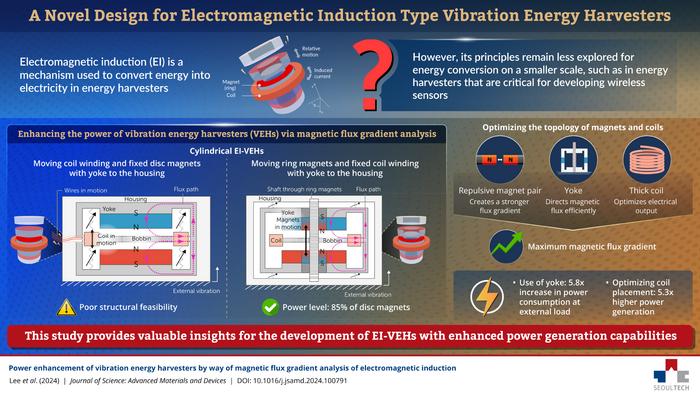
In recent advancements, researchers from Seoul National University of Science and Technology (SeoulTech) have introduced an innovative design that aims to improve the efficiency of electromagnetic induction-type vibration energy harvesters (VEHs). This breakthrough is rooted in the principles of electromagnetic induction (EI), which has long been recognized as a reliable method for converting mechanical energy into electrical energy. The researchers led by Associate Professor Dahoon Ahn have made significant strides in enhancing the design of these energy harvesters, which are crucial in the context of shrinking energy demands and a growing focus on sustainable power sources.
The innovative design proposed by the research team seeks to address the major limitation of traditional energy harvesters, which is their comparatively low power output relative to their size. The team emphasizes that there is an urgent need to increase power output, particularly as society looks toward more compact and efficient energy solutions. In their pursuit of this objective, the researchers explored new energy conversion mechanisms and hybrid structures that could offer better performance than existing models. Rather than simply increasing the size and strength of magnets or the number of coil turns, the team has focused on maximizing the magnetic flux change to optimize energy conversion.
A central focus of the team’s research has been on cylindrical EI coils and magnet cores, components typical in energy harvesters. The researchers utilized advanced computational simulations to model the behavior of these components and understand how adjustments to their configuration could lead to more efficient energy harvesting. The results of this research suggest that utilizing a repulsive magnet pair and incorporating a yoke—a structure used to guide and concentrate magnetic flux—can significantly enhance energy conversion efficiency. This approach allows for a more effective path for magnetic flux, which is critical in optimizing the performance of the energy harvesting process.
The findings indicate that the configuration of magnets and coils can yield a noteworthy improvement in power output. Specifically, the approach employing a yoke exhibited a remarkable increase in power consumption at external loads, recording an enhancement of approximately 5.8 times. This stark contrast to traditional methods paves the way for fresh perspectives on designing energy harvesters that are not only compact but also possess the potential to meet rising energy demands effectively.
Furthermore, the research team identified previously overlooked factors affecting energy conversion. By analyzing the points within the magnetic circuit where power generation became unfeasible due to a zero magnetic flux gradient, the researchers optimized coil placement. Their analysis revealed a striking 5.3-fold increase in power generation as coil placement was optimized, which underscores the importance of considering both magnetic configuration and mechanical design in energy harvesting technologies.
In proposing two distinct yet innovative designs for electromagnetic induction-based VEHs, the research team laid out the groundwork for future applications. One design features moving coil windings paired with fixed disc magnets and a yoke, achieving high power output. In contrast, the second design is based on moving ring magnets and fixed coil windings attached to a yoke enclosure. While the initial model produces substantial power, it lacks structural stability. The latter, however, manages to generate power at around 85% capacity while maintaining a robust design, indicating a practical approach for real-world applications.
The implications of these findings are broad and can be linked directly to the growing demand for mobile and portable power sources across various industries. Applications range from wearable devices to switches and wireless sensors, reflecting a shift toward energy solutions that can minimize reliance on batteries, thereby contributing to sustainability efforts. The potential of harnessing ambient energy through improved designs positions these novel VEHs as crucial elements in a future where energy needs are dynamically met with renewable resources.
The importance of this research is further underscored by its publication timeline. Results from this pioneering study were initially shared online on September 10, 2024, and later solidified in the December 2024 volume of the esteemed Journal of Science: Advanced Materials and Devices. This peer-reviewed platform highlights the significance of the research and the rigorous methods employed to achieve these advancements.
As the team at SeoulTech continues to refine these technologies, there is promise for the development of more efficient energy-harvesting systems. These systems could revolutionize how we think about power generation, embedding sustainable energy sources into everyday technology. This research aligns with global initiatives to harness energy more sustainably, providing insights that could influence future designs and applications of electromagnetic energy harvesters.
In conclusion, the work spearheaded by Associate Professor Dahoon Ahn and his team represents a critical leap forward in the field of energy harvesting. As researchers explore novel methodologies and optimize designs, the prospects for integrating these innovative solutions into daily technologies become increasingly probable, pushing the boundaries of what is achievable through electromagnetic induction.
Subject of Research: Electromagnetic Induction Energy Harvesters
Article Title: Power enhancement of vibration energy harvesters by way of magnetic flux gradient analysis of electromagnetic induction
News Publication Date: 01-Dec-2024
Web References: Seoul National University of Science and Technology
References: DOI: 10.1016/j.jsamd.2024.100791
Image Credits: Prof. Dahoon Ahn from SEOULTECH, South Korea
Keywords
Electromagnetic induction, Mechanical energy, Electrical power generation, Energy harvesting, Magnets, Vibration, Mechanical systems, Circuit development, Mechanical engineering, Electrical conductors, Magnetic fields, Materials engineering, Systems engineering.





